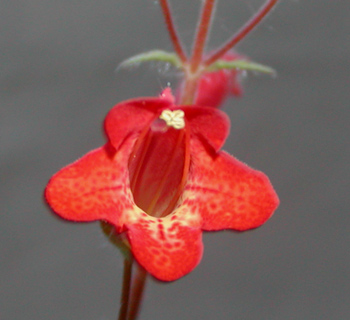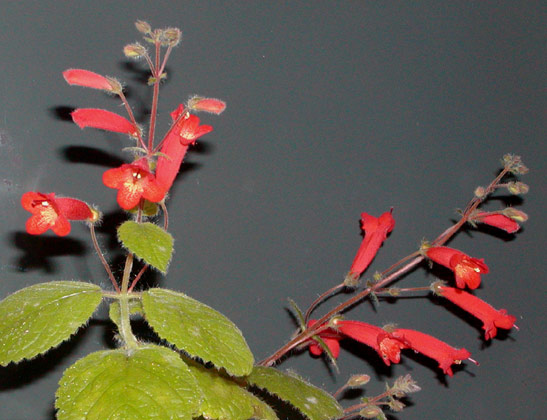
| Species list |
Hybrids list |
Tubers list |
Topics list |
Site index |
What's new |
Home page |

|
Sinningia nordestina x araneosa |
History |
|
I put S. araneosa pollen onto S. nordestina late in 2006, and got one fruit. I sowed the seed in January 2007 and got one seedling. For a time, I was uncertain whether it was an actual cross, or another S. nordestina (which would have been okay). In September 2007, it bloomed. The flowers clearly have S. nordestina in their background, since they have speckles derived from that species. They are equally clearly not S. nordestina, since that species has speckles on the outside of the tube, while this plant has speckles only on the inside, the outside being solid red (like S. araneosa). |

|
Flower countThe hybrid (so far) has only one (occasionally two) flowers per axil. S. nordestina also has one, while S. araneosa (in my culture) can have up to four flowers per axil. One can hope that the hybrid will eventually have more flowers. One can also be disappointed. As I write this in November 2008, the plant is blooming on two flowerstalks, but with exactly one flower per axil. The flowerstalk on the right in the picture has a second flowerbud from each of the two axils at the node just below the flower which has flopped over backward. |
HabitNeither S. araneosa nor S. nordestina has a robust stem, although araneosa's is a little stronger. The hybrid is fairly sturdy, although as the flowerstalk elongates, it tends to bend sideways. LeavesThe leaves of the two parents are similar, so it is not surprising that the cross has the same sort of leaves: hairy, light green, flexible, and relatively short. The picture above shows that the hybrid is susceptible to the same problem as S. araneosa: mildew. So far S. nordestina has exhibited no mildew symptoms, but I won't be surprised if it eventually does. |
| Attribute | S. nordestina | S. araneosa | S. nordestina x araneosa |
|---|---|---|---|
| Flower color | Red | ||
| Flower shape | Conical tube, widening toward corolla lobes | Tubular, upper two lobes extended | |
| Speckles | Inside and outside of tube | None | Inside tube only |
| Flower size | 2-3 cm | 4 cm | 3-4 cm |
| Flowers per axil | 1 | 1-4 | 1 usually |
| Inflorescence type | Extended axis | ||
| Tuber | Small (ca. 1 cm diameter) | Fullsize (see picture) | No obvious tuber the last time I checked, although the plant went dormant and then revived, so there must be something. |
|
Unfortunately, there are none, at least for my plant. Like its S. nordestina parent, this hybrid proved to have a short lifespan. It went dormant one winter and never revived. The hybrid plant was reasonably attractive. If somebody repeats the cross, it would be a good idea to self it vigorously the first time it bloomed, in order to get more generations, which might be more durable. |
| Plant Description |
|
| Growth | Indeterminate, like S. nordestina |
| Habit | Stem upright like S. nordstina, but sturdier and not as tall. |
| Leaves | Light green, hairy, and slightly sticky, like both parents. |
| Dormancy | Like S. nordestina. |
Flowering |
|
| Inflorescence | Axillary cymes, usually with just 1 flower. The flowering axis has very small leaves. |
| Season | Blooms in (late) autumn, like S. nordestina. |
| Flower | Red, tubular, with yellow throat and red speckles inside. |
Horticultural aspects |
|
| From seed | 9 months to first flowering. |
| Hardiness | Very unlikely to be cold-tolerant. |
| Recommended? | The flowers were attractive, but there was this mildew problem. It should be a good starting point for further hybridizing. |
Hybridization |
|
| Hybridizer | Alan LaVergne |
| Fertility | Not yet known. |
Botany |
|
| Taxonomic group | Both parents are members of the Corytholoma clade. |